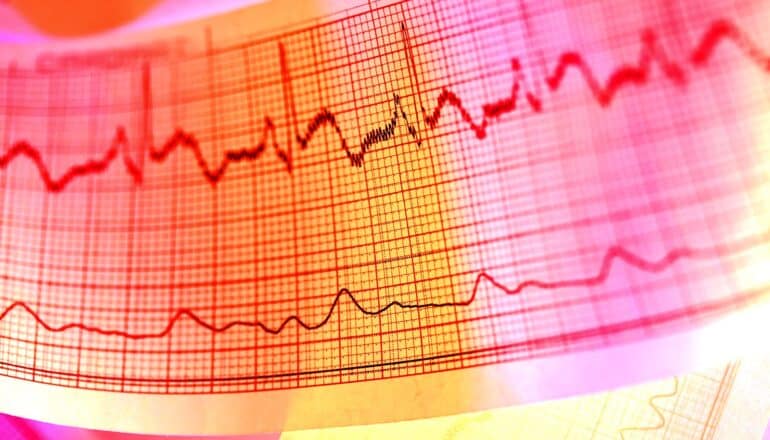
When researchers increased the heart rates of mice, the animals showed more anxious behavior.
Standing on the edge of a precipice, losing your way in a dark forest, or running into a crush will quicken your pulse—a physical consequence of the anxiety you experience. The new findings offer evidence of the reverse: A faster heart rate can generate anxiety.
When researchers artificially boosted an animal’s heart rate (the number of times a heart beats each minute), it behaved more cautiously in risky situations. The researchers traced the change to a particular region of the cortex, which appears to integrate heart rate with the brain’s perception of danger to determine the appropriate emotional response.
The findings address a question that has intrigued philosophers and scientists for more than a century: whether bodily sensations follow emotion, or the other way around. In 1884, the philosopher and early psychologist William James argued that, contrary to common belief, our emotional reaction to a situation comes after our physical reactions. “We feel sorry because we cry, angry because we strike, afraid because we tremble,” he writes.
“William James felt that bodily states actually represent the emotions in a fundamental sense,” says Karl Deisseroth, a professor of bioengineering and of psychiatry and behavioral sciences at Stanford University. Deisseroth is the senior author of a study in Nature that employed the latest advances in optogenetics—using light to activate specific cells—to test the hypothesis.
Deisseroth first pondered the question as a psychiatry resident, when he learned that certain cardiac diseases correlate with anxiety disorders—but nobody knew why. James’s belief “was really intriguing,” he says, “but it was hard to test because one would have to impose, very precisely, the bodily state first, which has been essentially impossible to do.”
Light controls the heart
Until the latest optogenetics approach, methods for changing a heart rate, such as electrical pacemakers or stimulant drugs, lacked precision or required invasive procedures.
Fortunately, Deisseroth, has spent the last 20 years developing optogenetics techniques that have allowed scientists to precisely control specific cell types in living animals. The method relies on genetically altering these cells to produce opsin, a protein that responds to light.
A few years ago, Deisseroth’s lab discovered an extra-sensitive opsin, called ChRmine, that can make even cells deep within the body respond to light from outside the body.
In the new study, researchers used ChRmine to control cardiomyocytes—the cells responsible for contractions of the heart. By genetically altering a mouse’s cardiomyocytes to produce ChRmine, the researchers were able to precisely control the animal’s heartbeat with external light.
“We really wanted a method where the animal could move freely while experiencing internal states, and to do that while illuminating the beating heart, we had to have the light coming from outside the body,” Deisseroth says.
The researchers created an optical pacemaker—a tiny fabric vest with an LED light shining toward the chest.
“We effectively have a mouse running around freely, wearing only a little vest,” he says. “We were able to provide sufficient light to a large moving organ (the beating heart) in a way that is noninvasive, allowing naturalistic behavior.”
To mimic the heart rate of a nervous, fearful mouse, the researchers used the optical pacemaker to bump up the mice’s heart rate to 900 beats per minute. (A calm mouse has a heart rate around 600 beats per minute.)
Heart rate and anxiety
Because mice cannot articulate their emotions, the researchers assessed their anxiety by watching their behavior. An anxious mouse is more risk-averse—more likely to avoid open, unprotected spaces, for example.
They found that a faster heart rate on its own did not noticeably change the mice’s behavior. Given the choice to roam two connected chambers, one in which the optical pacemaker was turned on to increase heart rate, the mice showed no preference.
When the mice sensed a hint of danger, however, a faster heart rate clearly made them more anxious. In a large, uncovered area, a higher heart rate made them stick closer to the walls. And, given the opportunity to press a lever for water, a higher heart rate made them less likely to do so if the lever occasionally delivered a minor shock. When it comes to anxiety, the researchers found, context mattered.
Next, using an intact-tissue imaging and labeling technique called CLARITY, also developed by Deisseroth, the researchers were able to see which areas of the brain were involved in interpreting signals from the heart. They homed in on the insular cortex.
“We recorded from that part of the brain live, and we saw the neurons specifically responded to the heart rate changes,” Deisseroth says.
When they inhibited the insular cortex, the anxious behavior generated by a racing heart nearly vanished.
That the insular cortex was the linchpin “made sense,” says Deisseroth. The area is known to be involved in interoception—the ability to perceive the body’s internal states, including heart rate, hunger, temperature, and pain.
“The insular cortex receives all kinds of information from all across the body, so it could be playing a general role across a broad range of emotional states,” he says.
The results suggest that the insular cortex could play a general role in integrating the brain’s perception of a situation with the body’s physical response, thereby evoking emotions.
This is essentially what William James had predicted more than a century ago. “He described basically a three-step process: First the brain perceives the situation, then the body engages in an appropriate response, and only then the organism feels the full emotion,” Deisseroth says.
The study had funding from the National Institutes of Health; the National Science Foundation; the Gatsby, Fresenius, Wiegers, Grosfeld, and NOMIS Foundations; a NARSAD Young Investigator Grant; the Stanford Medical Scientist Training Program; and Stanford Bio-X.
Source: Stanford University
The post Fast heart rates can drive anxiety, not just vice versa appeared first on Futurity.
from Futurity https://ift.tt/Gxy6XCw
No comments:
Post a Comment